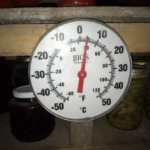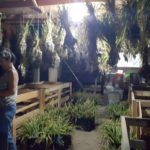2.4 Crop Storage
Harvesting
After harvesting your crops from the field, it is important to get them in clean bins, and into the shade or under shelter quickly. Especially in the summer heat, produce can start wilting quickly, which makes it less desirable to customers, and not store as long. You can also harvest early in the morning for temperature-sensitive plants (greens, herbs, etc). You will also want to harvest the crops that will take the longest to prepare, like carrots and beets that need to washed and bunched. Tomatoes don’t need to be washed or bunched, so those could be picked later on; try to avoid picking them in the heat of the day though as the sun dries them out a bit, making them less sweet.
The containers that you keep produce in will impact how long it lasts. Thick plastic bins with tight fitting lids work well for some types of produce, but condensation can build up inside and cause them to spoil more quickly. Clear plastic bins with loose fitting lids allows some produce to breathe, and allows condensation to escape. Greens that are mostly water will dry out in the Kamloops heat, so pick them early, and get them under cool water and into the fridge in the morning on harvesting days.
Other crops like squash, cucumbers, and peppers will get slimy and rot if they are too wet. After they are cleaned, dry them completely (as best you can), and put dry towels on the bottom of the bin to keep them dry.
After harvesting, produce needs to be cooled immediately. You can buy a fridge, if you are going to keep it small. If you have access to a small room, you can add an air conditioner to a room, or add a “Coolbot” to it to keep it around 4C. For vegetables like squash, potatoes, you just need cool storage.
Crop-Specific
- Alliums (onions and garlic): Sell fresh, or cure for 3-4 weeks and will store for up to 12 months.
- Berries: Pick every day, do not store for more than 2 days. Excess berries can be processed and frozen.
- Cucumbers: Sell fresh, store for up to 1-2 weeks.
- Greens: Sell fresh, store for up to 1 week.
- Herbs: Sell fresh or dried. Dry in a warm, dry location for 1-2 weeks, sell in a bunch or in plastic bags.
- Peppers: Sell fresh, store for up to 2-3 weeks if not blemished. Can dry hot peppers and make into flakes.
- Root vegetables (carrots, potatoes, beets, etc): Sell fresh, or store well for months if dry.
- Stone fruits: Sell fresh, store for up to 2-4 weeks.
- Summer squash (zucchini): Sell fresh, store for up to 2-4 weeks.
- Tomatoes: Sell fresh, store for up to 2-3 weeks if not blemished.
- Winter squash: Sell fresh, or store well for months if dry.
“If you don’t have a place to process or store crops, you have to get rid of all of your crops by the end of the year before they go bad. In a rural location, you can’t compete with low prices at grocery stores, but you might need to clear your inventory. Try to sell food to programs for Elders and youth. You will need to reflect on the extra crops you had at the end of the year, and make sure you don’t grow too much and not sell enough.” – Fred Fortier (Uncle Freddy’s Hothouse)
- Hanging garlic to dry
- Keep your cellar cool
- Cool room for long term storage
Long-Term Storage
Through the growing season vs overwinter.
- Cold storage (around 0-4C, 50-60% humidity)- a fridge or temperature-controlled root cellar to store produce and/or meat for weeks to months.
- Cool, dry, ventilated storage (around 10-16C, 60% humidity) – a basement usually works well for this, it can be used for drying out peppers or herbs, storing winter squash, potatoes, carrots, onions, garlic, etc.
- Warm, dry storage – for curing onions and garlic for a few weeks in the Fall
Further Reading



